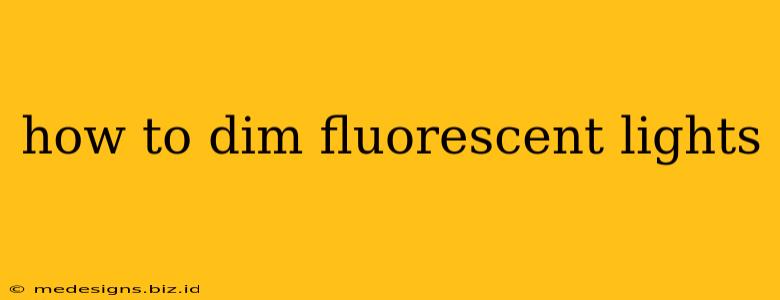Fluorescent lights, once known for their harsh, unadjustable brightness, are now available in dimmable varieties. This guide explores various methods for dimming fluorescent lights, addressing different types and considerations. Whether you're renovating, upgrading your existing lighting, or simply seeking a more comfortable ambiance, understanding how to dim fluorescent lights is key.
Understanding Dimmable Fluorescent Lights
Not all fluorescent lights are created equal. Before you even think about dimming, you need to ensure your lights are specifically designed for dimming. Trying to dim a non-dimmable fluorescent light can lead to flickering, buzzing, premature bulb failure, and even damage to your dimmer switch. Always check the packaging or the bulb itself for the words "dimmable" or a similar indication.
Types of Dimmable Fluorescent Lights
-
Compact Fluorescent Lamps (CFLs): These energy-efficient bulbs are often available in dimmable versions. However, they're gradually being replaced by LEDs.
-
Linear Fluorescent Tubes: These longer tubes are also offered in dimmable varieties, often requiring specific dimmers designed for their unique electrical characteristics.
-
LED Tubes: Designed as replacements for traditional fluorescent tubes, dimmable LED tubes offer excellent energy efficiency and dimming capabilities. These are increasingly popular due to their longevity and dimming performance.
Methods for Dimming Fluorescent Lights
The method for dimming fluorescent lights depends heavily on the type of fixture and bulb.
1. Using a Dimmable Fluorescent Light Fixture
The simplest and often most reliable method is to use a lighting fixture explicitly designed for dimmable fluorescent bulbs. These fixtures typically integrate the dimmer directly into the fixture's design, eliminating the need for a separate dimmer switch.
2. Installing a Fluorescent Dimmer Switch
For existing fixtures, installing a fluorescent dimmer switch is often the solution. Crucially, this requires a dimmer switch specifically designed for fluorescent lights. Using a standard incandescent dimmer will almost certainly damage the bulbs and potentially the dimmer itself. Ensure the dimmer switch is rated for the wattage and type of fluorescent bulb you're using.
3. Using a Dimmable LED Replacement
An increasingly popular method is to replace your traditional fluorescent tubes with dimmable LED tubes. These offer significant energy savings, a longer lifespan, and superior dimming performance compared to traditional fluorescent options. They’re often a straightforward replacement, making installation relatively easy.
Troubleshooting Dimming Issues
Even with dimmable bulbs and dimmers, you might encounter issues. Common problems and their solutions include:
-
Flickering: This usually points to an incompatibility between the dimmer and the bulb. Try a different dimmer specifically designed for fluorescent lights.
-
Buzzing: Similar to flickering, buzzing suggests an incompatibility or a problem with the wiring. Ensure correct wiring and check for loose connections.
-
Bulb Failure: Premature bulb failure can result from using an incorrect dimmer. Replace the bulb with a dimmable one and check the compatibility with the dimmer.
Choosing the Right Dimmer Switch
Choosing the right dimmer switch is critical. Pay close attention to these factors:
- Wattage Rating: The dimmer must be rated for the total wattage of the bulbs connected.
- Bulb Type: Specify the type of fluorescent bulb (CFL, linear, or LED) you will use.
- Leading-edge or Trailing-edge dimming: Some dimmers use leading-edge dimming while others use trailing-edge. Check your bulb's specifications to make sure they're compatible.
Conclusion
Dimming fluorescent lights successfully requires careful planning and selection of compatible components. By understanding the different types of dimmable fluorescent lights, choosing the appropriate dimmer switch, and troubleshooting potential problems, you can create a comfortable and energy-efficient lighting environment. Remember to always prioritize safety and consult a qualified electrician if you are unsure about any aspect of the installation process.
